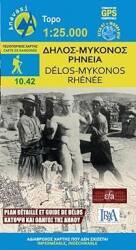
The Sacred Island of Delos
Delos / Δήλος
Mykonos is one of the most popular Greek islands, many thousands of visitors go there every year. But for most of its history, it has been overshadowed by a small neighbor. Delos, just a short distance away, was once the busiest island in the Aegean. Sometimes because Delos was a major political center, sometimes because it was a booming business center, and sometimes because it was the one of the most significant religious sites in the ancient and classical Greek world.
By the time that Homer was composing the Odyssey, Delos had become famous as the birthplace of the twin deities Apollo and Artemis. It was a major religious center from 900 BCE through 100 CE.
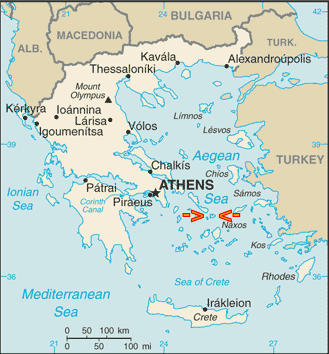
Map of Greece and the Aegean Sea. Mykonos and Delos are between the orange pointers.
Delos was the seat of the Delian League, the primary association of Greek city-states founded in 478 BC. It was founded to organize those Greek city-states against the armies of the Persian Empire.
At times Delos was heavily populated, and at other times it was a religious sanctuary with no non-priestly permanent residents. Either way, Mykonos provided supplies and was a stage along the way to visit it. Today you can't stay overnight on Delos, but you can easily visit it and tour its ruins on a day trip out of Mykonos.
Eccentric Visitors Arrive
The concept of the Grand Tour arose among the upper classes of Britain and a few other northern European nations in the mid to late 1600s. That led to the intellectual trend of Philhellenism. The middle and upper classes were increasingly interested in classical Greek history and culture, while international travel was becoming more practical. In the early to mid 1800s, Mykonos started to see visitors from western Europe, largely from Britain. They came to see Delos, the premier historical and mythological site in the Greek islands. Delos was nearly uninhabited, but Mykonos was just a few kilometers away.
Eccentric Britons began arriving at Mykonos. Some of them spoke the Koine Greek in which the New Testament was written. Others spoke Homeric Greek. Imagine a modern visitor to London speaking nothing but the Anglo-Saxon of Beowulf.
They would arrive by boat, having bought their way to Mykonos on a fishing or cargo vessel, and they would ask the harbor master for a place to stay. There was nothing like a hotel at the time, but various elderly widows would have spare rooms that they might rent. This was the start of the business of domatia, or rooms for rent, in the Greek islands.
These days it is much easier to get to Mykonos and to find a place to stay, at least if you don't show up during high season.
Check ferry schedules and buy tickets:
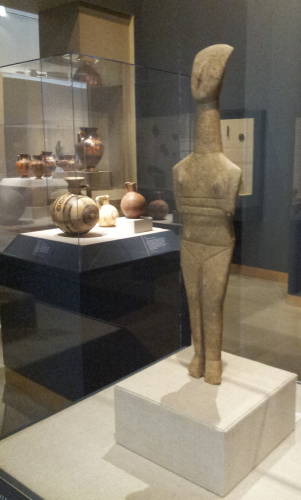
Anthropologists commonly assume that these distinctively geometric Cycladic figures represent a Great Goddess of nature, but there is no archaeological evidence that they were the focus of ritual worship. This one is from the Early Cycladic II period about 2500-2400 BC.
Mykonos is just a short hop by ferry or air from Athens. It's just three hours by fast catamaran from the Athens port of Pireaus to Mykonos, and four and a half to six hours by traditional ferry. It's only 45 minutes by air from Athens.
See my page about Greek inter-island ferries for more details on traveling around the Greek islands.
Prehistory and Ancient History
The Κυκλάδες, or the Cyclades, take their name from their arrangement as a rough circle of islands around the sacred island of Delos. The Cyclades islands are mostly the peaks of submerged mountainous terrain. Milos and Thera (or Santorini) are volcanic peaks.
A distinctive Neolithic culture combining elements of the cultures of western Anatolia and mainland Greece arose in western Aegean islands before 4000 BC. They grew emmer wheat and wild-type barley, raised sheep, goats and pigs, and speared tuna from small boats.
The Cycladic culture then arose in the Late Neolithic and Early Bronze Age. When the great Middle Bronze Age Minoan culture arose on Crete, most of the settlements on Aegean islands became much less important. But Delos remained significant because of the religious sanctuary that had already existed there for some time. By about 2000 BC, the Cycladic civilization was largely merging with the Minoan culture, and a prehistoric settlement existed at the peak of Mount Kynthos on Delos.
The Ionians largely settled the Aegean islands in the 10th and 9th centuries BC. They brought the cult of Leto, who was believed to have given birth to Artemis and Apollo on this island. This led to Delos' role as a religious center.
The Delian League was founded in 478, to organize between 150 and 173 Greek city-states into an alliance against the forces of the Persian Empire led by Xerxes I. The League was led by Athens, but held its official meetings in the temple on Delos and based its treasury on the island. The Greek forces had defeated the Persians at the Battle of Plataea the year before, and the Delian League was formed to organize the continuing resistance against this second Persian invasion.

The Athenian Empire reached its height about 450 BC
Sparta felt that with mainland Greece and the Greek cities of Asia Minor liberated, the war was completed. The Spartan king Leotychides proposed moving all Greeks from Asia Minor to mainland Greece to permanently avoid Persian domination. The Ionian cities, the Greek cities in Asia Minor, were originally Athenian colonies. Xanthippus, the commander of the Athenian forces, rejected the Spartan suggestion and said that Athens would protect its Ionian colonies. With this, the leadership of the Greek alliance transferred from Sparta and the Peloponnesian League to Athens.
A meeting was organized on the holy island of Delos. The announced goal of the meeting was to form a new alliance to fight the Persian forces. Thucydides said that the League's official aim was to "avenge the wrongs they suffered by ravaging the territory of the king." The reality was that there were three main goals: to prepare to repel a future invasion, to exact revenge upon Persia, and to divide the spoils of war. City-states belonging to the League could either provide armed forces or pay a tax into the League treasury. Most chose to pay the tax. The League members also swore to share the same friends and enemies, and dropped iron ingots into the sea in ritual symbolism of this pledge.
Athens' power and control of the Delian League increased rapidly. Then Pericles moved the League's treasury from Delos to Athens in 454 BC. He publicly said that he did this to protect it from seizure by the Persians. But his rivals, according to Plutarch, believed that Pericles was absconding with the wealth in order to fund elaborate building projects in Athens. This seemed like a reasonable assumption, given that Athens no longer accepted ships, weapons and men from the other League members, insisting that they just send money. It turned out to be true, as Pericles built the Parthenon on the Acropolis in Athens, along with many other non-defense expenditures.
The Greeks finally defeated the Persians for the last time, with a treaty formalized in 450 BC. The Delian League had really become the Athenian Empire by 454 BC. Athens used the League's navy for its own purposes. The Atheneans had acted to purify the sanctuary on Delos, and they sent a religious embassy annually. In 426 BC they again purified the sanctuary, removing all the coffins of those who had died on Delos and decreeing that no one should henceforth be born or die on the island. The dead were moved across the very narrow strait to Rineia. The map below shows how close that is to Delos.
War between the Athenians and the Peloponnesians soon broke out. Instead of fighting together against outsiders, Greeks were now fighting among themselves. The Peloponnesian War began in 431 BC, and the Athenian Empire and all semblance of the Delian League dissolved with the end of that war in 404 BC.
Practical Matters
The below is a portion of an aeronautical chart showing Mykonos and the nearby islands of Tinos, Syros, and Delos.

Aeronautical chart of the Aegean Sea, full map available from the Perry-Castañeda Library Map Collection at the University of Texas at Austin.
There have been various systems for transliterating Greek words into the Latin alphabet. The real names of the islands are Σύρος, Τήνος, Δήλος, and Μύκονος. This map used Síros, Tínos, Dhílos, and Míkonos. Today, English speakers usually spell them as Syros, Tinos, Delos, and Mykonos.
Nisís or νησίς means a small island. Νησίς Δήλος or Nisís Dhílos, "The Isle of Dilos".
When you arrive at an island by ferry, the main town or Hora is also the port.
So you have somehow gotten to Mykonos and its Hora or Χορα, the main town, also known as "Mykonos" to its many foreign visitors. You might have flown into the Mykonos airport and taken a taxi for 5–10€ to the Hora. Aegean Airlines, Astra Airlines, Olympic Air, and Sky Express operate year-round. During the high season, several airlines fly direct from Austria, Belgium, Germany, Israel, Italy, the Netherlands, Turkey, and the U.K. It's about 4 kilometers from the airport to town.
Or, more likely, you arrived by ferry. The inter-island ferries dock at the pier at the old harbor at the hora.
A very nice place to stay on Mykonos is Hotel Philippi, at Odos Kalogera 25 or Οδος Καλογερα 25, Hora, Mykonos, +30-22890-22294, chriko@otenet.gr
When you're ready to visit Delos, buy a ticket on one of the small ferries making daily trips to Delos and back. One of the shipping company offices along the waterfront can sell you the ticket the day before. This lets you get an early start—you have to return later that same day as you can't stay overnight on Delos.
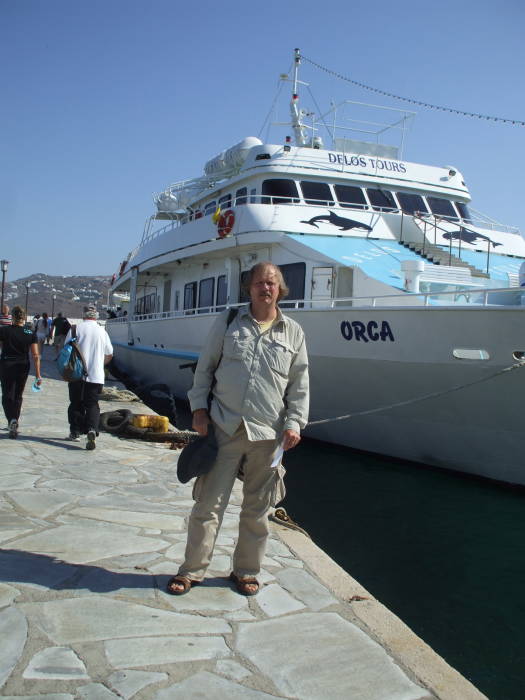
A small ferry takes you from Mykonos to Delos.
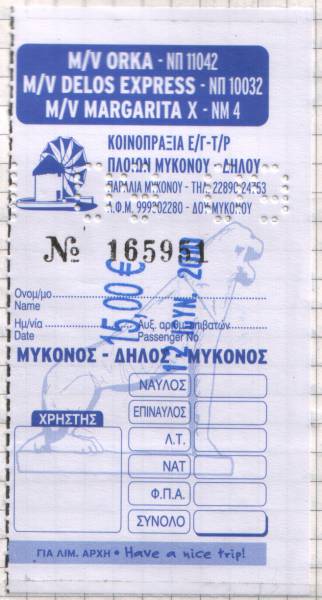
Buy a ticket for a day trip to visit Delos from Mykonos.
The ferry will probably leave from the Old Jetty at the west end of the waterfront, but verify the departure point when you buy your ticket. The crossing takes just about 30 minutes.
Arrival on Delos
The ferry from Mykonos has arrived on Delos, where it ties up near the ancient Sacred Harbor seen in the distance here.
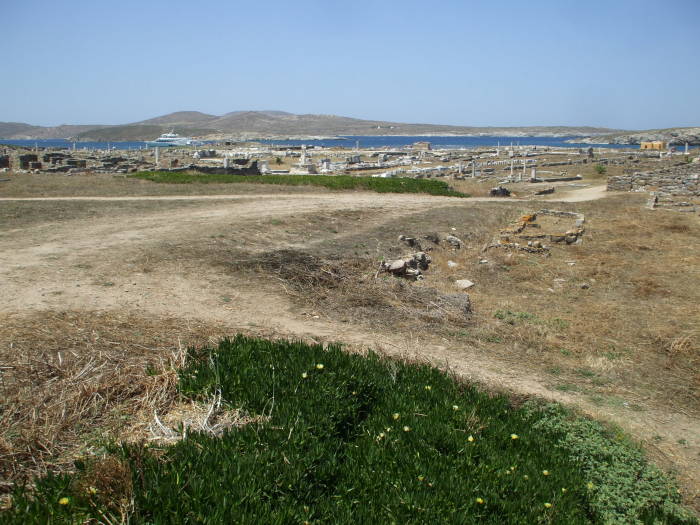
The ferry from Mykonos has arrived on Delos.
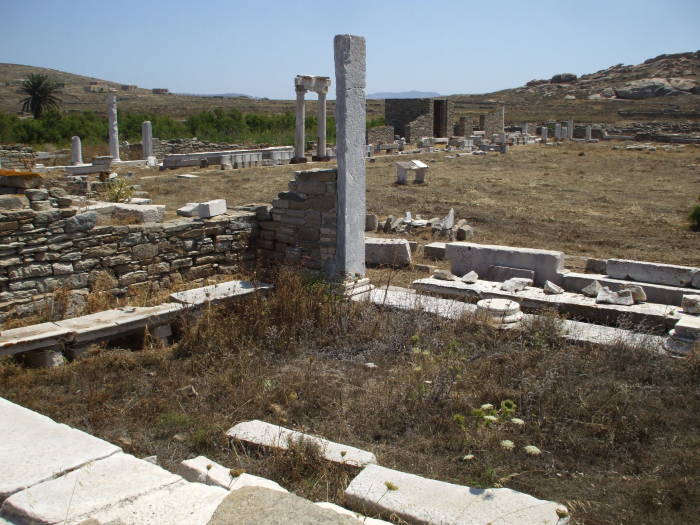
The large agora was the site of much business.
By 315 BC, Egypt controlled the Aegean. Delos was an independent democracy and member of a confederation of islands. It had its own archon, senate, and assembly, and it was entering its wealthiest age. Delos was still a religious center, and offerings poured in. It also had many diplomatic and commercial relationships.
The first Roman settlers arrived in Delos by 250 BC, and Roman merchants soon dominated the wealthy trade. Large agoras like this one were lined by stoas, arcades lined with shops, each arcade covered by a roof supported by a row of columns.
Roman domination of the local business environment led to political control of the island. The Roman Senate voted in 166 BC to make Delos a free port in order to counterbalance the influence of Rhodes. The Roman decision allowed the Athenians to return to Delos, with what appeared to be full control of the island given to an Athenian Epimeletes but with Rome retaining true power. The decision expelled the native Delians, who had come into being after that Athenian rule about no births and deaths had expired.

Broad streets cross the ancient city.
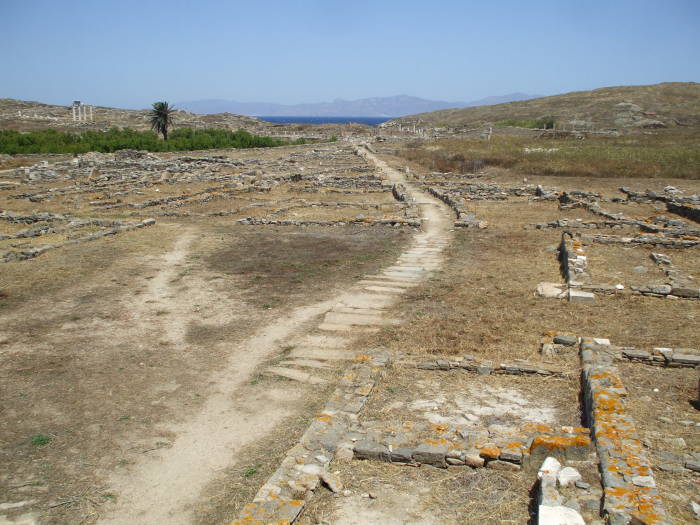
Broad streets cross the ancient city.
The Hermaists were a group of Roman-aligned merchants from the Italian peninsula. The agora above is the Italian Agora as it is where their prosperous businesses were based.
Delos became the slave market of all of Greece, with as many as 10,000 slaves being sold on a single day.
The city-state of Κόρινθος or Kórinthos, which we English speakers tend to spell Corinth today, lies just south of the Isthmus, the narrow strip of land connecting the near-island of the Peloponnesus to the Greek mainland. It had been a member of the Achaean League since 243 BC.
In 146 BC, Rome declared war on the Achaean League. A force of 23,000 infantry and 3,500 cavalry plus Cretan and Pergamese troops under the command of Roman consul Lucius Mummius besieged Corinth. When Mummius' forces entered the city, he ordered his men to kill all the men in the city, sell the women and children into slavery, and burn the city.
Corinth had been famous for its fabulous wealth, and it was left a smoking ruin. The few survivors moved to Delos.
Delos was still the major religious sanctuary of the region, but commerce had grown to the point that it now overshadowed the religious rites. The Greek geographer, philosopher and historian Strabo wrote that the great religious festival had become a trade fair on an heroic scale. People still came to the religious festivals in large numbers, but commerce was the island's source of wealth. Syndicates of merchants from Tyre, Beirut, Alexandria and elsewhere around the Mediterranean formed trade associations, and the foreign communities erected their own monuments and temples to their own deities.
Although Delos was so famous, yet it became still more so, and flourished after the destruction of Corinth by the Romans. For the merchants resorted thither, induced by the immunities of the temple, and the convenience of its harbour. It lies favourably for those who are sailing from Italy and Greece to Asia. The general festival held there serves the purposes of commerce, and the Romans particularly frequented it even before the destruction of Corinth. The Athenians, after having taken the island, pair equal attention to the affairs both of religion and commerce. But the generals of Mithridates, and the tyrant, who had occasioned the defection of (Athens from the Romans), ravaged it entirely. The Romans received the island in a desolate state on the departure of the king to his own country; and it has continued in an impoverished condition to the present time. The Athenians are now in possession of it.
Rheneia is a small desert island four stadia from Delos, where are the sepulchral monuments of the Delians. For it is not permitted to bury the dead in Delos, nor to burn a dead body there. It is not permitted even to keep a dog in Delos.
Γεωγραφικά or The Geography by Strabo, circa 20-7 BC
Getting back to the religious festivals from when Delos was in its prime as a purely religious sanctuary, they were known as the Delia and held in honor of Apollo and Artemis and their mother Leto. Forms of the religious rites go back to prehistory.
The religious festival had largely died out by the time the Atheneans got involved in the late 400s BC and re-established the rites. The Athenian ambassadors were initially called Deliastae and later the Theoroi. They sailed from Athens' port of Piraeus to Delos in a vessel called the Theoris, supposedly the vessel which Theseus, mythical founder-king of Athens and son of Aegeus and Poseidon, had sent to Athens after his adventures killing the Minotaur in the Labyrinth in Crete.
An εξέδρα or exedra is a semicircular recess often topped with a semi-dome and set into a building's façade. It was a room opening onto an open stoa or street with a semi-circular high-back stone bench, a place where one might have a philosophical conversation.
The Athenians re-established the religious rites and began the Delian Games, held every four years. The Athenians would arrive in their sacred vessel Theoris, landing at the Sacred Harbor. They would then march in procession up the Dromo or the Sacred Way, lined with exedrae and monumental statues. While marching they sang the Prosodion, the hymn recounting the story of Leto and the birth of her divine twins Apollo and Artemis.

The Terrace of the Lions is at the Sanctuary of Apollo.
The Dromo or Sacred Way led to the Hieron of Apollo, an enormous complex of temples, altars, and the ruins left from a thousand years of rituals from an evolving series of religious traditions. The Terrace of the Lions originally had at least nine lions carved in Naxian marble. Five remain here. Another was taken away by the Venetians and is at their Arsenal in Venice.
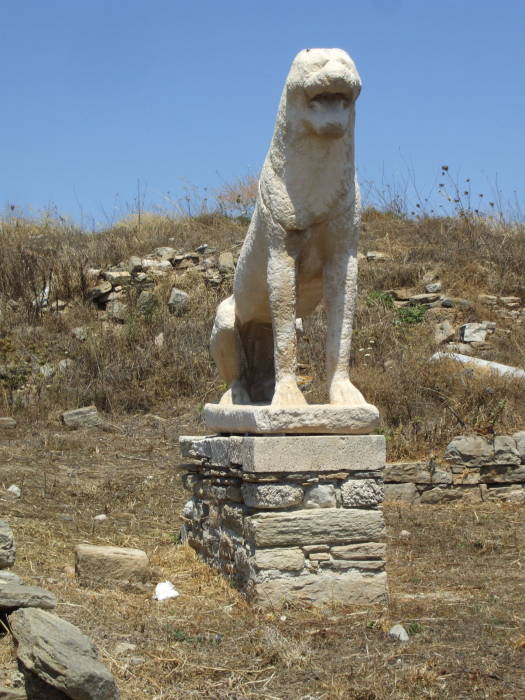
The Terrace of the Lions is at the Sanctuary of Apollo.
The sacred procession made a solemn tour of the religious complex. Then they sacrificed the victims supplied by the Delian locals.
The exclusively female midwinter ritual Lenaea was the "Festival of the Wild Women". A man or bull representing the god Dionysus would be torn to pieces and eaten by Maenads in the forest. A baby representing the reborn Dionysus was presented later in the ritual. The first month of the Delian calendar was Lenaion, named for this ritual.
By the classical times in which the Athenians administered the rites at Delos, the human sacrifice had been scaled back to the sacrifice of a goat. The version of classical times included wine miracles, in which the priests of Dionysus would seal water or juice in a room overnight. The next day, it would be discovered that Dionysus had turned the water or juice into wine.
The Sacred Lake was nearby. With modern understanding of sanitation and disease origins, the Sacred Lake was drained in the 1920s and remains dry. Malaria is no longer the problem it once was on Delos.
Back in its malarial heyday, the Sacred Lake housed the sacred swans and geese of Apollo. It also watered the nearby palm tree commemorating the sacred palm Leto clung to while giving birth to Apollo.
Malaria and Geometry
Some time during the first half of the 4th century BC (that is, during 400-350 BC) a "plague" broke out on Delos. Very likely it was just more malaria. But the locals concluded that this was, of course, a plague sent by Apollo. So, they should go ask the Oracle of Delphi because (a) she was an oracle and (b) the temple at Delphi had been dedicated to Apollo since some time in the Greek Dark Ages in the 11th to 9th centuries BC.
The Oracle, vague and ethylene-addled as always, said that they should double the size of the altar dedicated to Apollo. The Delians consulted Plato, who said that Apollo's altar was a regular cube and so the oracle was challenging them to figure out how to double the volume of a cube. Go study geometry and the plague will go away.
The actual "doubling the cube" problem is scaling the cube's side length by a factor of ∛2 or 21/3, the cube root of 2. You can't construct this value with nothing but a compass and straightedge, but you can do it by mechanical means. Plato gave the problem to Eudoxus, Archytas and Menaechmus, and then scolded them for solving it by mechanical means instead of pure geometry. But it was first proved in 1837 that it simply cannot be done with a plain straightedge and compass. You can do it with a marked straightedge or ruler, which is how it can be solved by origami.
Temples for all Religions
There are temples and altars all over Delos, not just within the complex dedicated to the primary local deities of Apollo and Artemis. Some were for religions imported by merchants, sometimes modified to align somewhat with practices already established locally.
Ba'al ShrinesThe Institution of the Poseidoniasts of Berytos was an association of Syrian merchants and ship owners from Beirut. They worshiped one of the various deities known as Ba'al, possibly the primary one known as Hadad, the god of rain, thunder, agriculture and fertility, and the Lord of Heaven. Or possibly he was another patron deity of their home city. He might have been Melqart the son of El from the Phoenician tradition, who was known as Ba'al of Tyre.
Whichever Ba'al this was, the locals figured Ba'al was Poseidon in foreign garb and considered the group to be Poseidoniasts.
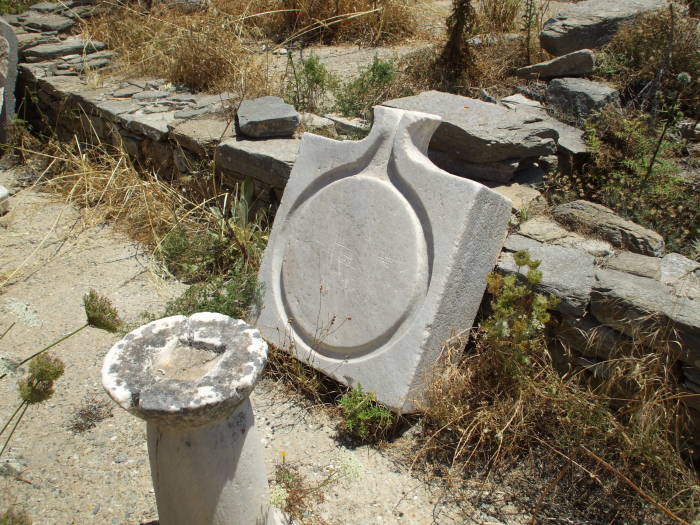
This altar was used to make sacred offerings.
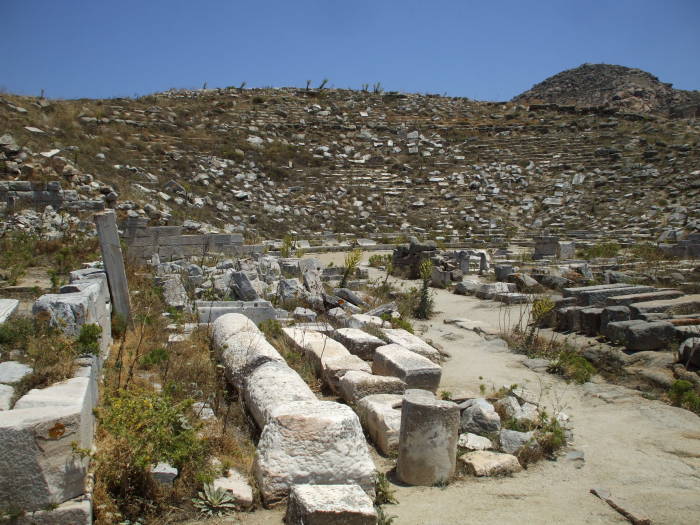
The theatre is in a residential district south of the harbor.
Residential Districts
A residential district extends south from the Sacred Harbor. Unlike the sacred district to its north, with large sanctuaries, public buildings and open spaces, the residential district has closely spaced structures along narrow twisting streets.
The theatre is in this residential district. It was built in the early 3rd century BC and held about 5,500 spectators.
Large Delian homes were often built with rooms grouped around a central courtyard that was accessed via a corridor from the street.
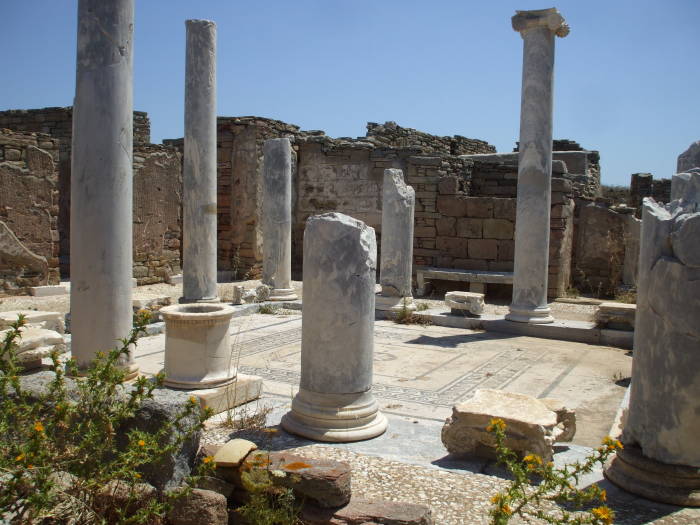
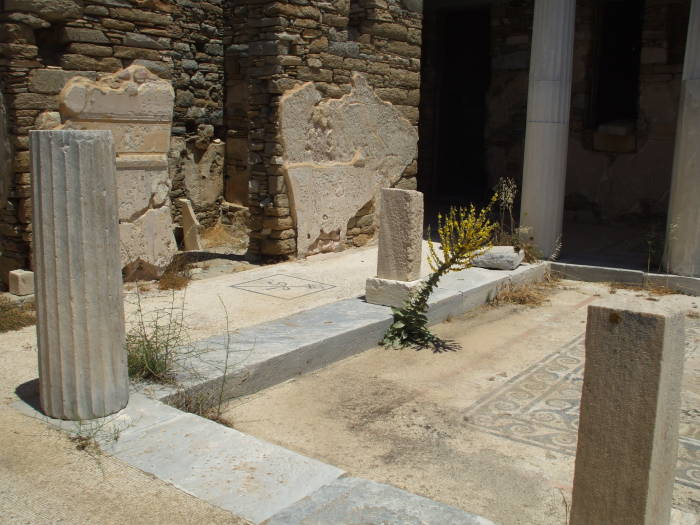
A peristyle is an array of columns. These would have supported a roof, making for a narrow covered walkway around the courtyard which was open to the sky.
Another design has a large hall with peristyle columns on one side, and one or two stories of rooms on the other sides.
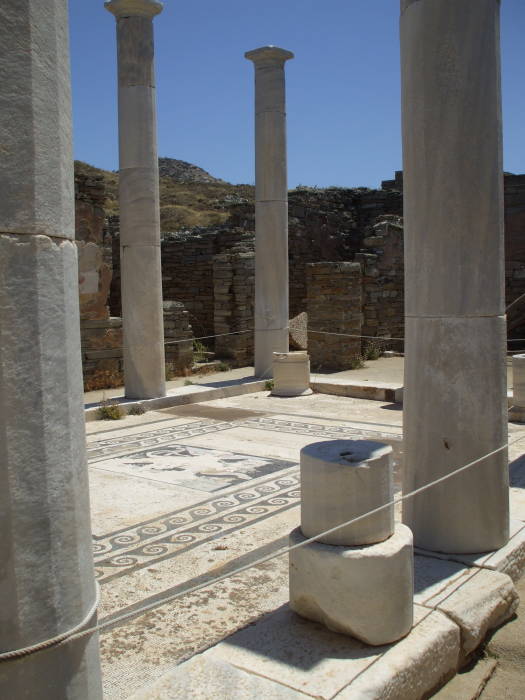

The local museum houses some of the objects found at Delos, although the majority is at the archaeological museum in Athens. Mount Kynthos rises in the distance beyond the museum.
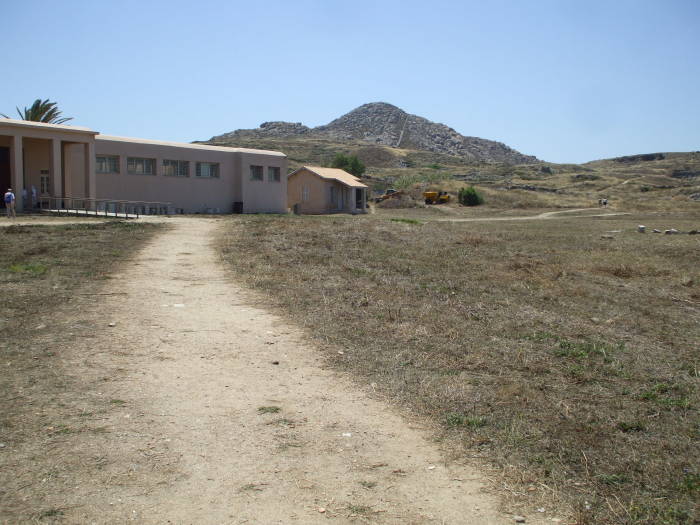
Mount Kynthos rises beyond the museum.
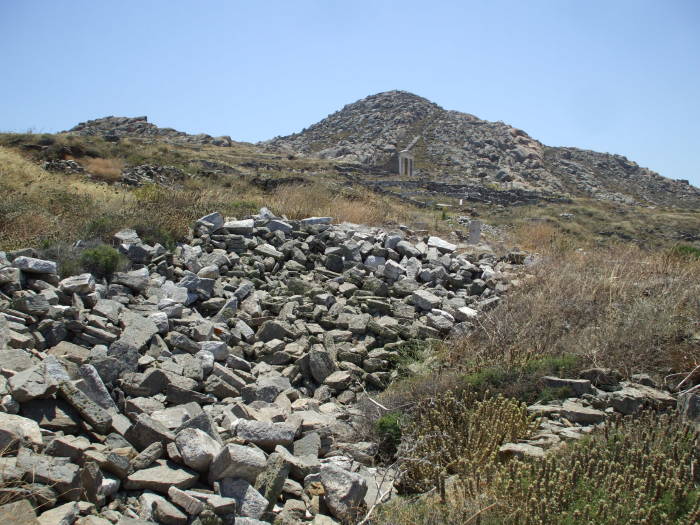
The Sanctuaries of the Foreign Gods are along the path to Mount Kynthos.
The path to Mount Kynthos passes through a district known as the Sanctuaries of the Foreign Gods. Merchant communities from Egypt, Syria and elsewhere erected temples to their deities here.
Delos had sophisticated infrastructure, including these large water storage cisterns. Almost all of the Cycladic islands are hot and dry with very few springs. Water collection and storage was crucial. See the Toilets of the World site for details on the latrines and other plumbing of the nicer homes in the residential district and near the sacred precincts.
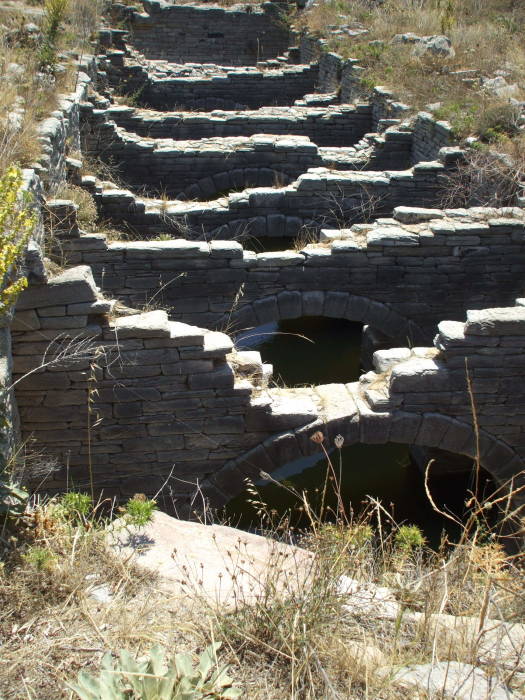
Water storage cisterns were critical.
Returning to Mykonos
Watch your time, you have to return to Mykonos that afternoon. You will be ready to relax along the waterfront on Mykonos after a day exploring Delos.
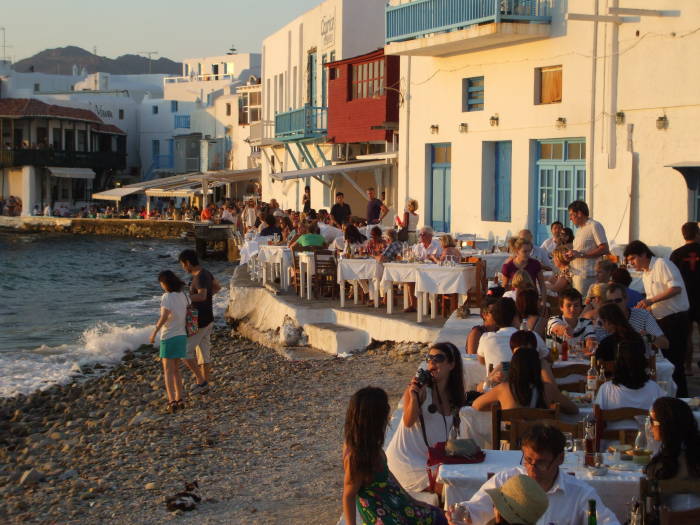
Return to Mykonos that afternoon.
Delos Fades Away
As for Delos, it was destroyed in the First Mithridatic War in 88 BC. Menophanes, a general of Mithridates, took the island. He killed the native and foreign men, enslaved the women and children, seized the sanctuary treasures and all the merchandise, and then burned the city to the ground.
The island was retaken by the Roman general Sulla the following year and returned to Athenian control. It was partially rebuilt with Roman aid.
Delos was sacked again in 69 BC. The Roman legate Triarius built a wall around the city to prevent further invasions by pirate forces, but Delos was on its way out.
In the 2nd century AD, Pausanias said that Delos would be completely uninhabited if the temple guards were withdrawn. This is from his Έλλάδος Περιήγησις or Description of Greece, his lengthy first-hand description that serves as a critical link between classical history and modern archaeology.
A century later Philostratus reports that the Athenians tried to sell the island but found no one interested.
Control of the Cyclades passed from one group to another. It was mostly barbarians and pirates for a while.
The Cycladic islands fell under Byzantine control. Then the Fourth Crusade sacked Constantinople and the conquerors divided much of the Byzantine Empire for their own control. Venice took control of the Cyclades, forming the Duchy of Naxos. The Venetian Duke of Naxos then handed out control of various islands to his relatives and friends.
The Ottoman Turks took Constantinople in 1453, making it their new imperial capital. Hayreddin Barbarossa, the Grand Admiral of the Ottoman Navy, captured the Cyclades for the Ottoman Empire in 1537-1538 (except for Tinos, where the Venetians held out until 1715). The Ottomans largely left the administration of the islands to the existing infrastructure of Venetian noblemen.
The Venetians, the Turks, and then the inhabitants of nearby Mykonos and slightly more distant Tinos used the sacred island as a quarry, disassembling the sanctuaries and other buildings to build structures elsewhere.
